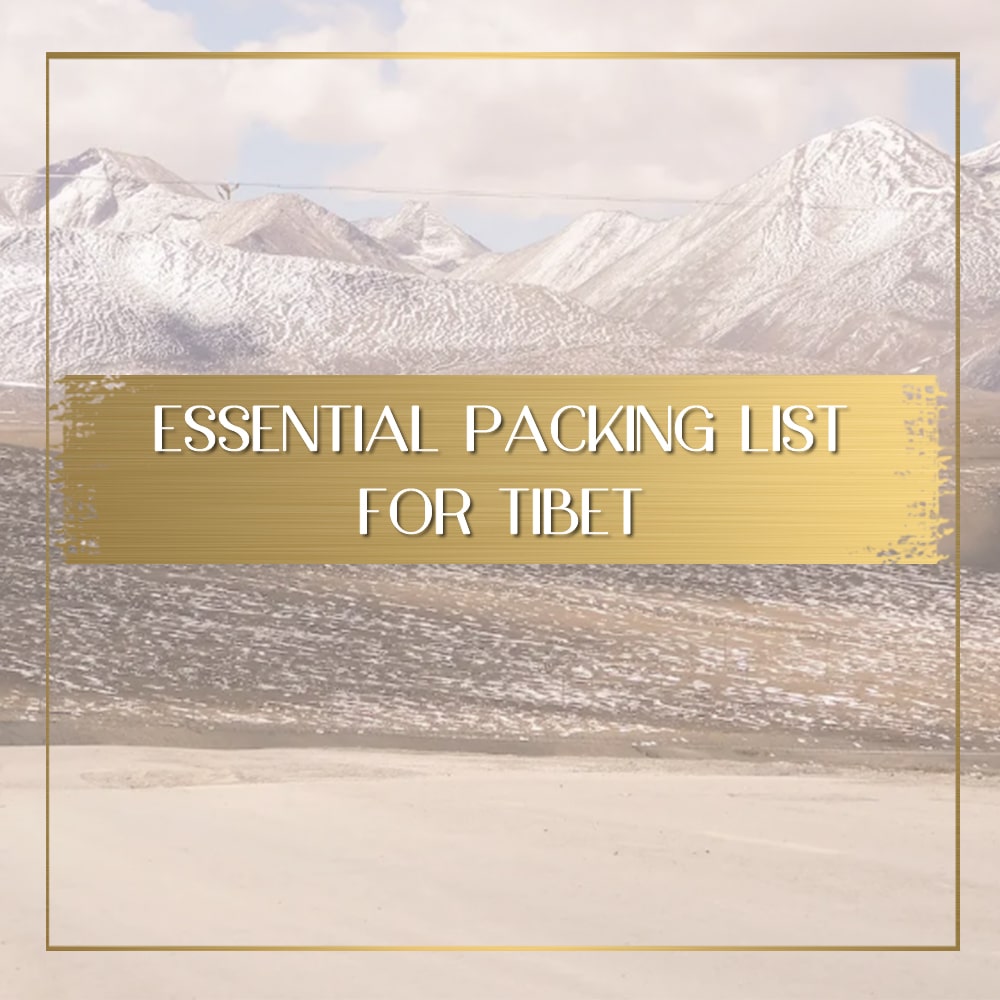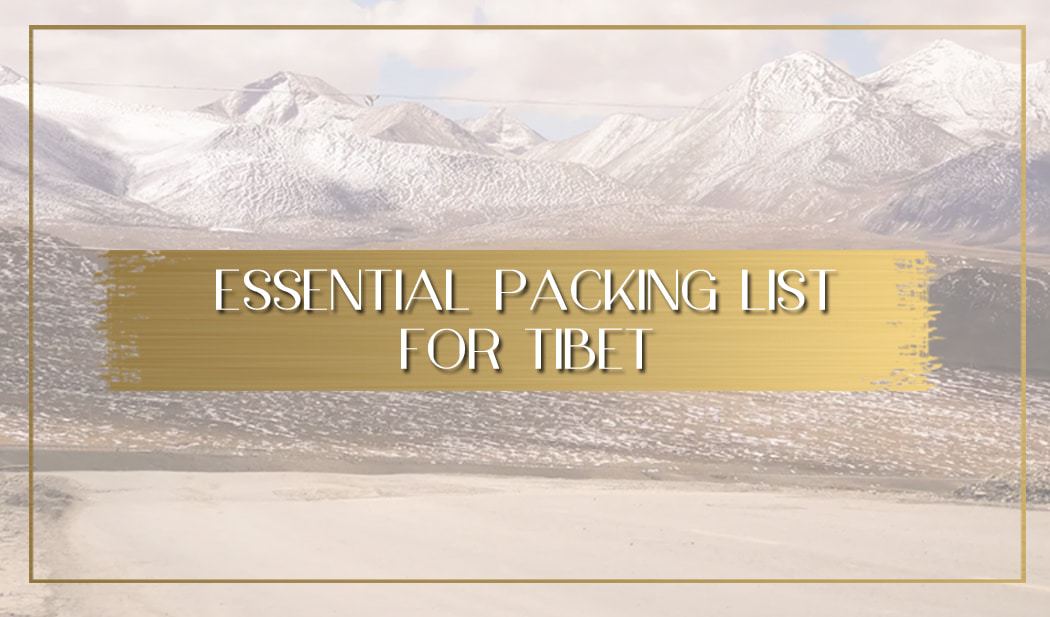This article was first published in June 2017 and updated in October 2019.
Tibet’s altitude and weather are major factors in how comfortable and enjoyable a trip will be so it is vital to pack all the essential items on a trip to Tibet. This is a packing list that I deem critical for your trip and works in conjunction with my essential guide to Travel in Tibet.
I would go as far as to say that there are no optional items, these are all the things you should make sure to bring with you and put on your packing list for Tibet.
Clothes to bring
Even in the summer months the high altitude will bring cold nights, particularly at Base Camp where the wind blows almost incessantly all year round.
If you go in the peak months of mid-April to mid-June and mid-September to mid-October extra warm clothes are a must. Here are a few items you should add to your suitcase:
- Thermal underwear, trust me, you will thank me for this when you go to sleep at the Base Camp tourist tents or Rombuk Monastery without any heating and the thermometer hits -10, plus the wind chill factor. You would wrap yourself around with a blanket outside if you could. Male underwear here.
- A thick hat. Laugh all you want but the Russian style hats that they wear in Siberia saved my life at night when the temperatures (mid May) were well below -10 and I was trying to keep warm under 5 thick blankets.
- Heavy duty gloves or forget about taking any photos. If you want, the thinner but effective Timberland gloves can be used with your phone, that is if your phone works in the cold, both my Nexus and my iPhone shut down.
- Thermal socks because the feet are the hardest part to keep warm.
- A windproof, waterproof really warm jacket. This jacket for men and this 3 in 1 one for women (I’m a huge fan of Arctix) are great options. The male one comes with hand extensions to keep you warm even without gloves on.
- Boots. You don’t really need trekking boots for the journey as you will be sitting in a car or walking on flat surfaces most of the time. Even the trek to Base Camp, if you have the energy despite the altitude, is on a well marked gravel road. But the boots are useful to keep warm. For men, the Solomon Speedcross waterproof are a sure winner that I keep seeing on more and more people. They also make them for women but I would much prefer the higher boots.
- A scarf is essential unless your jacket goes all the way up. It will be useful to wrap yourself around and also to protect your throat and nose from the dryness.
- Sunglasses that truly protect from the sun. I love Oakley for anything that is heavy duty and outdoorsy. They are not fashionable but then again, you need to protect your eyes from the strong sunrays and the wind and these are a winner.
Important items of a more personal nature
This may seem counterintuitive but all skiers will know that sunscreen is a must in the mountains. Don’t make the mistake of thinking that because it is cold you won’t need it, the sun rays are extremely strong high up so a good all-day sunscreen is essential. Choose one that is not greasy.
I am a huge fan of Biore Face Milk because it is silky and dry and you will not know you are wearing it. You can even put makeup on top of it and it comes in a small bottle that easily slips into your pocket. Lip balm is equally important as the arid weather is so dry your lips will be permanently chapped.
Tissues and wet wipes galore, they should be stocked everywhere and will most definitely be used in the bathroom, to wash your hands before and after a meal, to blow your nose when you sneeze (an unavoidable effect of the altitude), etc.
They are very useful and I successfully went through 5-6 packets in the trip so don’t underestimate the amount you will need. Wet wipes with a nice scent will also be useful when you need to use the appalling toilets (the worst thing I have ever experienced in my travels). Hand sanitizer, because there is never any water or soap in any toilets, not even at restaurants.
Which brings me to the next item you should absolutely pack: a small essential oil bottle. Trust me on this one, the toilet experiences in Tibet will make you crave something nice to put under your nose and smell instead of the stench of the toilets and this is a good range of aromatherapy oils that may also help you sleep better at night.
If you are shaving, make sure not to bring anything that is pressurised, it is dangerous at such high altitudes as it could explode succumbing to the added altitude. In Lhasa, all shaving creams are in tubes.
Bringing snacks for the trip is also a good idea as you will spend a long time on the road and sometimes there isn’t anywhere to stop for a meal. I suggest cereal bars and nuts as they travel best.
Medication
Altitude will surely play up during your visit. There are a few items that will be no doubt useful. One of them is eye drops. The dryness at such altitudes may makes your eyes dry and puffy. You should also include a nose spray to keep moisturised.
Check which is the best kind with your pharmacist. This is essential and I cannot stress enough how important and useful it will be. The dryness made our noses constantly bleed. The five of us had this issue which persisted well into the return to lower altitudes. It is not only annoying but also painful.
Headache tablets and painkillers will come in handy because the altitude will be felt, especially at Base Camp where we all had a sleepless nights and very strong headaches. Antihistamines should be carried if you are prone to allergies, the additional dryness may cause a break out.
Although you should always bring diarrhea tablets when traveling, because you don’t know how your body will react to different food and water, it is also wise to bring constipation tablets because at high altitude your digestive system goes into rest as your body uses all its energy for your respiratory system. Bring tablets for heartburn as well in case your body does not like the heavy foods and chilli or you have too much of the terrible Chinese wine!
If you are prone to getting car sick all I can say is: good luck. The drive to Everest is through a truly winding road stretching 60km going up to 5,000m and down the other side. It is tough even for those who don’t get motion sickness. Out of the five in my group two got slightly dizzy, one threw up. If you are truly prone to getting car sick you should consider taking medication and laying down for the whole journey.
Last but certainly not least is altitude sickness medication. Consult with your doctor prior to leaving as some tablets need to be taken pre-trip. Most people take Diamox. Not everyone will have the time to acclimatise to the altitudes, by staying in Xining for a few nights for example, even so, the altitude might catch you off guard so this is essential.
Electronics and other accessories
You won’t be staying at a fancy high-altitude hotel, like those in Ladakh, so a battery pack comes in handy to make sure your electronics don’t run out of juice, especially when you sleep at Base Camp and have no access to electricity. A great one that can even charge your laptop is the Baseus 30000mAh one which comes with two USB ports and a quick charge one but beware that the Chinese airport officials may make you check it in.
Socket adaptors are of the China type but that is, the three pin one not the two pin that many multi-country adaptors offer, although most of the plugs will also work with the European two pin round option. I particularly like this one because it comes with a two socket option as well as USB ports. Bring extra batteries for all your essential electronics too. If you are a photographer, make sure to bring a bag to keep your equipment safe along the bumpy roads.
Apart from all the items above make sure to bring enough cash. Cards are not accepted outside of Lhasa, and even in the city you will struggle. You will need more cash than you think, for example, to pay for photographs at every temple and monastery where you may have to fork out USD10 per person or more.
Now that you know all about what to bring to Tibet, it’s time to start planning your trip, read on to find out more about traveling this amazing country.
- Complete Guide to Tibet
- Surprising and interesting facts about Tibet
- 9-day Tibet itinerary – from Lhasa to Everest
- Review of Shangri-la Lhasa, Tibet
- Helicopter tour to Everest Base Camp (from Katmandu)
If you’re looking to visit nearby Bhutan, check out the articles below:

